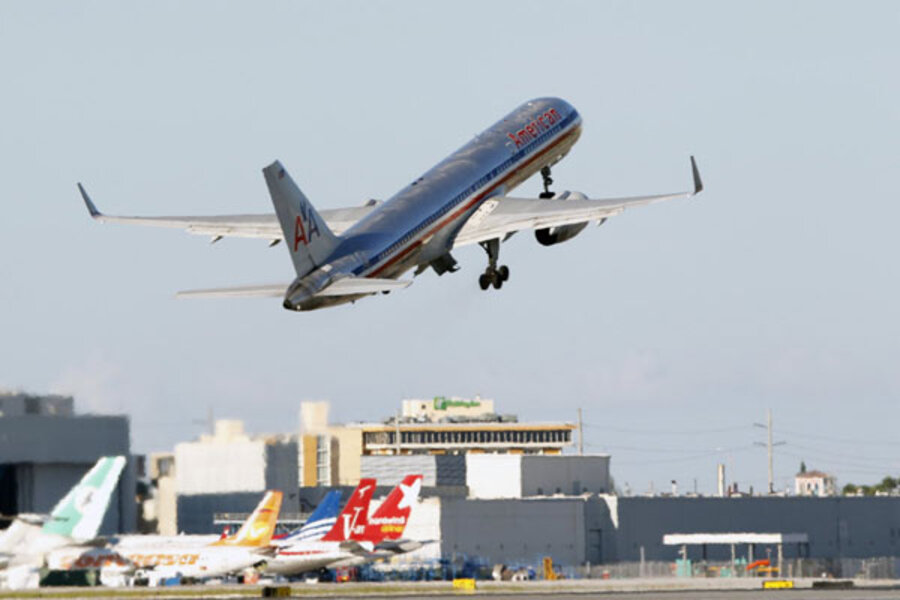Boeing 757 hole forces flight 1640 to make emergency landing
Loading...
| Dallas
Investigators are looking into what caused a hole to rip open in the fuselage of an airline jet as it cruised at 31,000 feet, causing a loss of cabin air pressure and forcing the pilot to make an emergency landing.
The 1-foot-by-2-foot hole opened in the roof shortly after American Airlines Flight 1640 took off from Miami bound for Boston on Tuesday night.
A man aboard the plane said passengers panicked after oxygen masks were released and the pilot put the jet into a sharp descent.
9 states ban cellphone use while driving. Is yours on the list?
"It was pretty chaotic and confusing. It just was kind of surreal. We kind of looked at each other when the masks came from the ceiling and thought, 'This is it,'" said Edward Croce, 34, of Braintree, Mass.
Croce tried to send a goodbye text message to his son back home, but his hands were shaking uncontrollably.
The pilot guided the Boeing 757 back to Miami, and none of the 154 passengers and six crew members were injured, according to American.
"We were shaken up and everyone was in shock," said Croce, who complained that the airline didn't provide medical attention for passengers once they were on the ground.
Federal Aviation Administration spokeswoman Kathleen Bergen said Friday that an inspection of the plane revealed a hole in the upper part of the fuselage near a cabin door toward the front of the plane.
The National Transportation Safety Board is investigating. Board spokesman Keith Holloway said the agency doesn't yet know what caused the hole.
"We'll be looking at (metal) fatigue and mechanical issues and everything," he said.
American Airlines spokesman Tim Smith said the airline has assigned a team of engineers and maintenance technicians to look at the aircraft. He said American has talked to Boeing, the NTSB and the FAA. The airline took the plane out of service.
Officials said Boeing is working on a safety alert called a service bulletin that will direct airlines to do more inspections of parts of older 757 aircraft.
The government could order airlines to ground their 757s while they are checked, but officials said that was unlikely if Boeing determines that problems can be detected with visual inspections. Airlines were allowed to keep flying their jets last year after a similar incident involving a Southwest Airlines Boeing 737.
The American jet is 20 years old and had gone through about 22,000 takeoffs and landings, Holloway said. American, which had refused to give the age of the plane, said its fleet of about 120 Boeing 757s averages 16 years, which its spokesman said "is considered mid-life by most in the industry."
Boeing declined to comment much beyond saying it was providing technical help to safety investigators.
Last year, a Southwest Airlines Boeing 737 was forced to make an emergency landing after a crack between two sheets of aluminum skin turned into a gaping hole in the roof. That case led Boeing and the FAA to direct airlines to increase inspections of parts of the 737.
The Southwest jet was 15 years old and had made more than 42,500 takeoffs and landings.
Age becomes a concern because of the risk of metal fatigue — cracks that develop from the constant cycle of pressurizing planes for flight, then releasing the pressure. It's like inflating a balloon, then letting the air out, and repeating the process thousands of times.
In 1988, cracks caused part of the roof of an Aloha Airlines Boeing 737 to peel open in flight. A flight attendant plunged to her death.
John Goglia, a former National Transportation Safety Board member and an expert on aircraft maintenance, said rips in the upper fuselage can be caused by metal fatigue, by damage during repairs, from bumping into something like a jetway or by corrosion due to exposure to moisture.
Boeing produced about 900 copies of the original version of the 757, called a 757-200 series, including the American jet involved in Tuesday's incident. The first one was delivered to Eastern Airlines in 1982, and the last went to Shanghai Airlines in 2005, according to Boeing's website. Boeing began making a larger version of the 757 in the late 1990s.
Goglia said the 757 is "a rock solid airplane" that has proven to be reliable.





